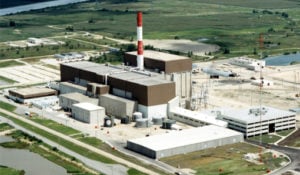
LaSalle Nuclear Plant. Photo:www.exceloncorp.com
Workers began repairing cracks in the screen house at the LaSalle County nuclear plant in Illinois on May 21, 1996. The screen house is a building on the shore of a lake. Pumps draw water from the lake through large concrete tunnels and supply it to the plant for cooling. The tunnels have strainers to keep debris from the lake from reaching the plant.
Workers removed some of the concrete around the cracks to create suitable surfaces for a foam material they applied to seal the cracks. This work continued for about a month.
On June 19, operators at LaSalle discovered debris clogging all three strainers of the non-essential service water system, which supplies cooling water to non-emergency equipment and structures, like the turbine building and its equipment. The strainers filter small particles from the lake water to protect the pumps and in-plant components from fouling. Corn cob material used to sandblast the exterior concrete walls of the screen house found its way into the water and then into the strainers. Workers unclogged the strainers.
Five days later, all the non-essential service water strainers were again found to be fouled. This time, the diesel-driven fire pump strainers were also fouled. The foam sealing material was the culprit this time. Workers had mistakenly drilled through the concrete ceiling of a tunnel and injected the material clear through the ceiling and into the water. The significance of the errant material was discounted at the time because workers believed it was buoyant and would therefore simply float harmlessly on the surface of the water, thereby not blocking the essential service water pumps taking water from the bottom of the tunnel.
On June 28, divers discovered a significant quantity of foam sealant material near the bottom of the service water intake tunnel near the essential service water systems. This revelation invalidated the earlier buoyancy argument. So the argument was revamped. The condition was now discounted because the foam was now believed to be the complete opposite of buoyant. This magical material was now deemed so heavy that it would sink and stay firmly anchored on the bottom of the intake tunnel.
The NRC inspectors at LaSalle stepped in and forced the plant’s management to consider the consequences of the foam sealant material blocking the essential service water system pumps. This common-mode failure represented a real potential for disabling all the emergency cooling water systems at the plant. Because the plant could not function safely without cooling water in event of an accident, the reactors were shut down. They remained shut down until the debris was removed from the screen house area.
On January 24, 1997, the NRC imposed a $650,000 fine on plant’s owner for the foam sealant material problem and some other miscues.
Our Takeaway
The pseudo-logic applied at LaSalle in this episode does not appear often, but more often than it should. A mistake allowed the foam sealant material to get into the water. Workers cavalierly dismissed the consequences of the mistake on the fanciful notion that the material would float out of harm’s way. When divers found the material on the bottom, the notion became even more fanciful. Now, this very same material would sink and rest firmly on the bottom of the tunnel out of harm’s way.
The utter absurdity of these unjustifiable excuses should have been revealed by how the problems became known. Stuff neither floating harmlessly at the surface nor resting harmlessly of the bottom was repeatedly clogging the service water strainers. Opportunities to identify the real cause of the problem instead provided opportunities to fabricate another lame excuse.
The size of the NRC’s fine was based on the potential severity of the problem. Had the essential service water system been disabled, nearly all the emergency systems at the plant would have been disabled or impaired.
Had the size of the fine been based on stupidity, it would have been larger.
“Fission Stories” is a weekly feature by Dave Lochbaum. For more information on nuclear power safety, see the nuclear safety section of UCS’s website and our interactive map, the Nuclear Power Information Tracker.
